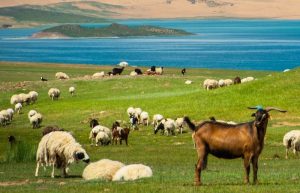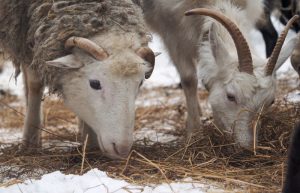
How to Care for Goats and Sheep
Sheep and goats. They are both popular on the homestead for their meat, milk, and companionship. They are similar in size and appearance. They share many of the same care requirements and shelter needs. If you plan on raising goats and sheep together, it’s important to know the differences in care in order to best serve the animal.
So, what are the differences between goats and sheep? There are actually many differences between goats and sheep. Here is a list of how goats and sheep are different:
- sheep usually tend to be larger than goats
- wool sheep require specialized care for their coat compared to goats
- goats tend to have curved horns while sheep are usually polled or have rounded horns
- sheep are “grazers” while goats are “browsers”
- goats can be more independent than sheep
- both sheep and goats have difference defense styles
- goats often test fencing while sheep will stay in its confines
- sheep tend to have a better resistance to parasites compared to goats
While sheep and goats are quite similar, they are also very different from one another. Educating yourself about the individual needs of each species can help you raise a well-integrated co-existing flock. Read on to learn more about their physical differences, their behavioral differences, and their unique needs.
Physical Differences Between Sheep and Goats
Sheep Tail vs. Goat Tail
You may have heard that the easiest way to differentiate between a sheep and goat is by looking at its tail. This is indeed an accurate method – a goat’s tail will point upward, while a sheep’s tail will hang down. Another difference in tails – the sheep’s tail will often be docked (for sanitary reasons). There is typically no need to dock the goat’s tail. Read on for more differences in physical appearance between goats and sheep.
Sheep Size vs. Goat Size
While similar in size, sheep do tend to be larger (and heavier) than goats. Sheep carry more meat on their loins and their backs, while goats tend to be thinner. There are many different breeds of both sheep and goats, but a large sheep breed can reach up to 300 pounds, while a large goat breed can reach up to 200 pounds.
Sheep’s Wool vs. Goat’s Hair
Many will attempt to differentiate a sheep from a goat by the presence (or absence) of wool. On its face, this sounds pretty straightforward. Until you are met with a smooth Dorper Sheep or a woolly Angora Goat.
Most sheep breeds have wool and need to be sheared once a year. This is an important note if you are looking into the differences in care between goats and sheep. However, there are a handful of popular sheep breeds that grow hair, not wool. Popular hair sheep breeds include the Barbados (and American) Blackbelly, the Dorper, and the Katahdin. Want to raise sheep for wool? Learn the best sheep breeds for wool by visiting my article Best Sheep for Wool: Top 8 Sheep Breeds for Wool.
Most (almost all) goats have hair. However, like the hair-sporting sheep breeds, there are a handful of goat breeds that produce wool. The most popular woolly goat is the Angora Goat. The Angora Goat produces beautiful wavy ringlets of mohair, and should be sheared semi-annually.
Goat Horns and Beards
 Think you can pick out a goat because of the presence of horns? Goats are better known for their horns – thin and straight – that are present on most goat breeds. But while many sheep breeds are naturally polled (having no horns), many sheep breeds do have horns. The difference in sheep horns is that they are most commonly curved back on the sides of the head, and not straight like the goat’s. Of course, both goats and sheep can have their horns removed to make handling them easier.
Think you can pick out a goat because of the presence of horns? Goats are better known for their horns – thin and straight – that are present on most goat breeds. But while many sheep breeds are naturally polled (having no horns), many sheep breeds do have horns. The difference in sheep horns is that they are most commonly curved back on the sides of the head, and not straight like the goat’s. Of course, both goats and sheep can have their horns removed to make handling them easier.
Another clue is in the beard – goats commonly have beards of varying lengths, while sheep are beard-less.
Behavioral Differences Between Sheep and Goats
There are several unique behavior differences between goats and sheep, including their dietary habits and their personalities.
Dietary Differences Between Sheep and Goats
Sheep are known as “grazers”, while goats are known as “browsers”.
Sheep can usually be seen in the pasture with their heads to the ground, searching for and eating a diet of mainly grass and clover. For this reason, having a large, healthy pasture is important when keeping sheep.
Goats, on the other hand, tend to look for food at eye-level. They will graze as a last resort, but will more often consume shrubs, leaves, vines, and even twigs. This makes goats a great choice in taking care of landscape debris – but they do not consistently match the sheep when it comes to lawn-mowing.
While sheep rely more heavily on a pastural setting, goats can be kept in many different environments. If you’re looking to utilize wooded pasture, consider goats! To learn more, check out my article Can Goats Live in the Woods?
Flock / Herd Behavior: Sheep vs. Goats
Sheep are known as strong flockers – following the flock without hesitancy. If you can get one sheep to move, you can get the entire flock to move. This is a survival technique, and one that has been successful for them for thousands of years. You will rarely see one lone sheep when there are more nearby – instead, the flock will tend to naturally stick together. While they graze, they will rotate their eyes upward so that they have their flock members in view at all times. To learn more about providing a community setting for your sheep, check out my article Can You Keep a Sheep By itself? Essential Guide.
Goats are known to be mischievous, getting themselves into precarious, and often humorous, situations. This is because the goat is more independent than the sheep. Goats are led by their curious natures, often wandering away from the herd to investigate something they see or hear. Because goats are browsers instead of grazers, they are always looking around for their next meal (even if they decide that next meal is over a fence, or in a tree). For this reason it is often said that shepherds must protect their sheep from their environment, while goatherds must protect their environment from their goats.
Sheep’s Head Butt vs. Goat’s Rearing
Both rams (male sheep) and bucks (male goats) will head butt for play, defense, and when competing to mate. The difference between the two is that rams will rush forward and head butt their foe, while bucks will rear up and come down head-first. There is a recorded incident of a ram and buck fighting, where the buck reared up, intending to come down head-first into the sheep. Instead, the sheep rushed forward and head-butted the goat in the exposed belly, winning that day’s scuffle.
Goats and Sheep have Different Needs
Goats and sheep have many similar care requirements – for example, a simple 3-sided shelter will work in most situations for both sheep and goats. But goats and sheep also have unique needs that you should be aware of.
Containment of Sheep and Goats
Because of the inquisitive nature of goats, goats will usually require more secure fencing than sheep. Most sources recommend goat fencing to be at least 48” in height. While this height will prevent most goats from jumping – it is important to make sure there are no obstacles or structures near the fence line that a goat can use to climb out. Goats are strong climbers, and can often be seen on the roof of a structure, or in a tree.
It is also important to make sure there are no gaps larger than 4-6”. A horned goat will often stick their head through small gaps, and can get their horns stuck trying to pull their heads back in. This can be a dangerous situation for a goat.
You can certainly use these same requirements to fence in a flock of sheep, but they will typically do just fine with a shorter fence. Of course, a fence is not only used to keep your livestock (or pets) in – they are also used to keep predators out. For this reason, it is not a bad idea to raise the height of the fence or use electric fencing for both sheep and goats.
Weather Considerations for Sheep and Goats
While individual breeds will have different needs, sheep and goats do tend to tolerate different climates. Sheep do best in cold climates, with their thick wool and meaty frames to protect them from brutal Winters. Goats do not do as well in cold weather, and will need adequate shelter from the wind, rain, and cold if kept in these climates.
Goats, on the other hand, do better than most sheep in hot and humid climates. It is not as easy for sheep to stay cool in tropical climates and if you would like to keep sheep in this weather you will need to carefully research different sheep breeds.
Both sheep and goats tend to do well in hot, dry climates, though sheep do still have a harder time because of their wool. You can make this easier on them by timing your annual shearing to coincide with the weather – most farmers shear their sheep in the Spring (another bonus besides keeping the sheep cool, is it helps with hygiene during Spring lambing).
Regardless of climate or animal, it is important to provide a shelter so that both sheep and goats can escape from the heat, wind, or rain.
Health Differences Between Sheep and Goats
While goats and sheep are similar in terms of health, there are some key differences to be made aware of.
Many say that overall sheep are hardier than goats. Because sheep are grazers, they are exposed to various worms and other parasites that can be found on the ground and in manure. They have evolved over time to have a natural resistance to parasites because of their grazing behavior. Alternatively, goats have evolved eating off of the ground for the most part, making them more susceptible to parasitic infections when exposed.
In addition, they are both susceptible to troublesome bacterial infections in their feet – though with sheep this comes in the form of Foot Rot, while goats are more likely to get Foot Scald. Both are treatable and should be checked for regularly.
Goat or Sheep – Which is Right For You?
While there are many differences between sheep and goats, they are both popular choices for the homestead for a reason – both are relatively easy to care for, both provide value to the farm, and both make excellent companions.
Are you just now planning to invest in sheep? You can get a complete overview of caring for sheep by visiting my article How To Care For Sheep: Essential Guide For Beginners.
